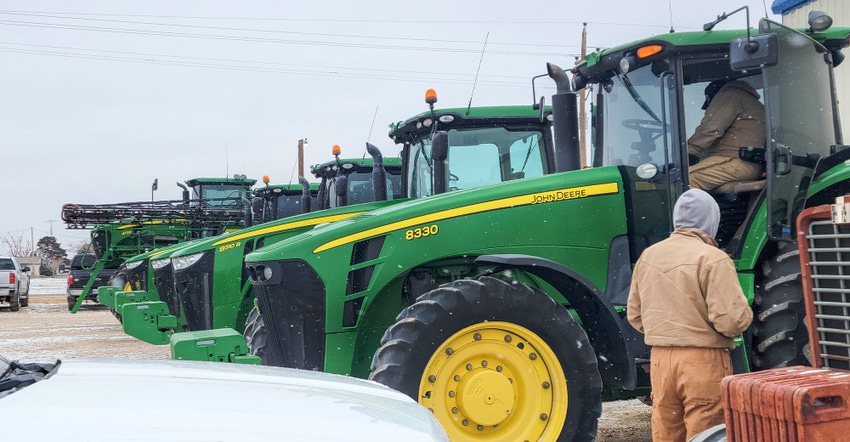November 3, 2022

Buy new or repair used? As input costs continue to climb in ranching and farming, producers need a smart equipment strategy.
The dealership purchase price of a new farm implement, such as a combine, can top as high as $500,000, while a slightly used model can still carry a hefty price tag of around $150,000. Older versions with more years and hours under the hood vary widely in value.
When the pandemic hit in 2020, the value of used farming equipment skyrocketed. Farm sales, estate auctions and private treaty transactions became hotspots for buyers searching for a good deal. Gregg Pickens, owner of Pickens Auctions, said he has noticed a significant increase in auction crowds during the past couple years, including bidders in person and online.
“At an estate auction in Oklahoma earlier this spring featuring mid-size farm and ranch equipment, a tractor with 1,100 hours in excellent shape brought more used than it did when the family bought it brand new,” Pickens said.
See, Equipment orders: 'Late. Real late.'
Auction crowds are also growing with buyers beyond the state and region. Pickens said 4-wheel drive tractors between 15 to 20 years old with less technology and fewer diesel exhaust fluid requirements are a hot commodity.
“We hosted a construction and farming auction in March where one tractor went to a buyer in Minnesota, and the other went to Pennsylvania,” he said.
From used to new, dealerships like P&K Equipment in Stillwater are low on new inventory that dropped off during the pandemic.
“Two to three years ago, we could place orders and have certain models here relatively quickly,” said site manager Seth Kline. “Now you can’t even place an order with some product lines, and other models are probably a good six months out.”
Some less-common parts are difficult to find in stock in P&K’s service department, but overall equipment sale numbers are holding strong.
See, Much of Oklahoma receives 'billion dollar' rain
“Demand is still high. Everything coming in is going right out,” Kline said. “We don’t have the luxury of having a lot of stock to choose from, but if we don’t have it here, we may have it somewhere else.”
One advantage to purchasing new equipment versus used is the favorable financing rates and availability of parts for newer models. The reliability of a warranty is also a big factor, and as long as repairs stay within a brand’s specs, Kline said warranties are guaranteed with repairs performed by certified technicians.
Roger Sahs, an Oklahoma State University Extension specialist in agricultural economics, said the best way to determine whether to buy new equipment, opt to purchase used equipment, or repair current equipment, is to keep good production and financial records. When comparing new to old, consider cost minimization.
“There are producers out there who are over-mechanized and have unproductive debt,” Sahs said. “They could get by with less. They’re spending too much money on owning a piece of machinery, new or used, as opposed to hiring a custom operator, which may be the least cost option.”
Precision agriculture technology streamlines fieldwork, and newer implements with all the bells and whistles can address those needs. On the other hand, equipment can be retrofitted with fewer expenses if producers with smaller operations have the time and skills to make repairs themselves.
“Farmers and ranchers don’t realize how much money they have wrapped up in machinery and how much it’s costing them on a per acre or per hour basis,” Sahs said. “They need to record costs and then compare those to custom farm and ranch rates. That will help them decide if it’s better to own and operate that machine or get the job done cheaper with a custom operator.”
The latest OSU Extension Oklahoma Farm and Ranch Custom Rates fact sheet provides more information on custom harvest costs. The Machinery Ownership versus Custom Harvest fact sheet, co-authored by Sahs, also offers insight on how to determine equipment needs.
While dealerships continue to play catch-up following the pandemic, industry leaders, such as Ryan Dolezal, sales manager of TractorHouse magazine, said don’t expect any discounts or price drops anytime soon.
“Prices will remain strong overall due to low inventory, higher commodity prices and stressed supply chains,” he said.
Source: OSU Extension
You May Also Like




